MHN222487: Innovation and Creativity - Interview Analysis
VerifiedAdded on 2022/09/25
|10
|2474
|24
Essay
AI Summary
This essay analyzes the innovation strategies of Christy Lakeman, the director of Cafe Artum, a local coffee shop. The essay explores Lakeman's innovation in creating a unique ambience to attract customers, focusing on how this approach has increased market share. It integrates theories of innovation and management, including the innovation matrix, marketing innovation, and the innovator's dilemma, to evaluate Lakeman's approach. The analysis covers the coffee shop's homely atmosphere as a marketing tool, its implications on revenue, and the allocation of resources. The essay also critiques the resource allocation using the 70-20-10 rule, suggesting improvements in product innovation. Overall, the essay concludes that Lakeman's emphasis on ambience has been successful, although a more balanced approach to resource allocation could further enhance the coffee shop's competitive edge.
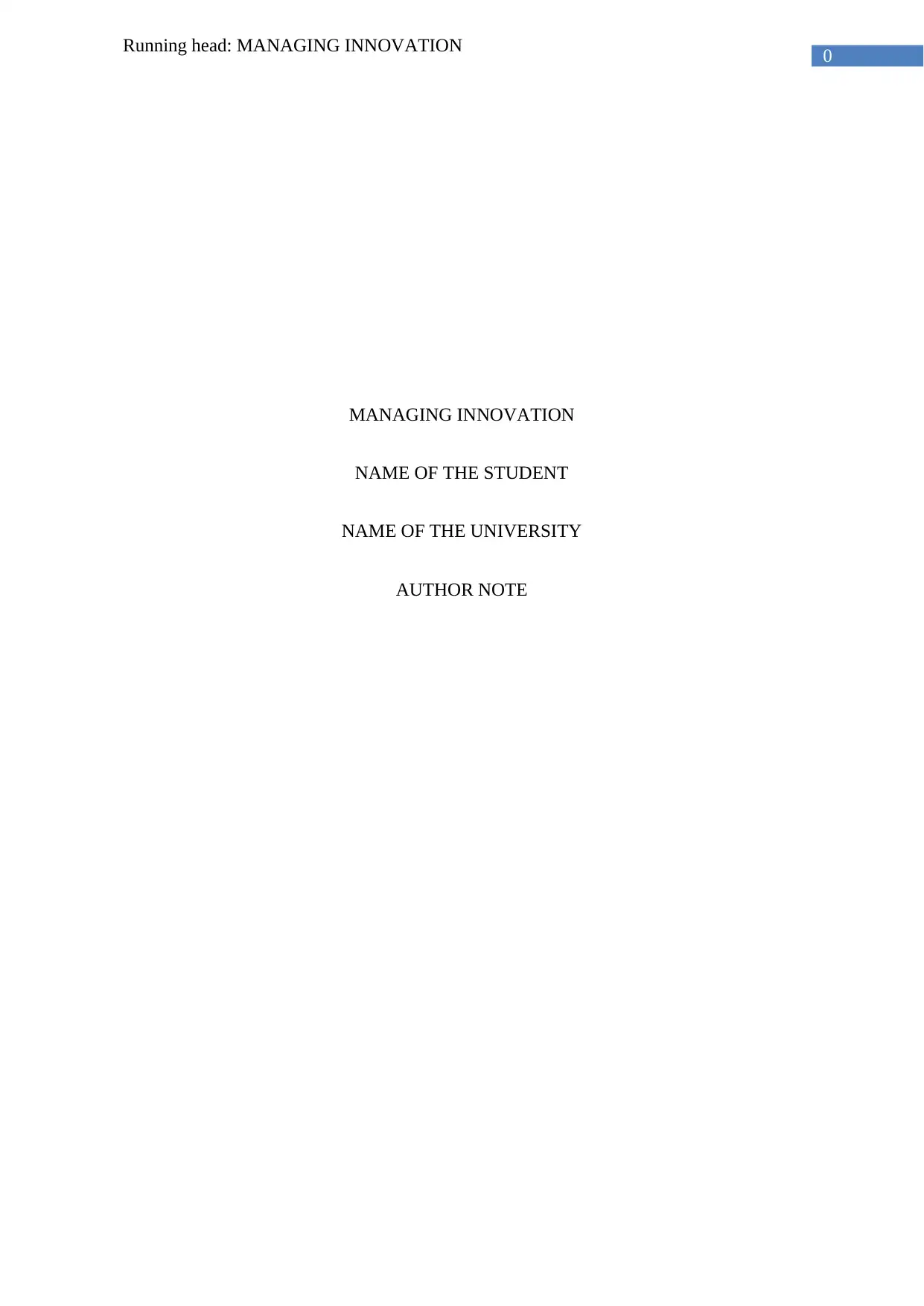
0
Running head: MANAGING INNOVATION
MANAGING INNOVATION
NAME OF THE STUDENT
NAME OF THE UNIVERSITY
AUTHOR NOTE
Running head: MANAGING INNOVATION
MANAGING INNOVATION
NAME OF THE STUDENT
NAME OF THE UNIVERSITY
AUTHOR NOTE
Paraphrase This Document
Need a fresh take? Get an instant paraphrase of this document with our AI Paraphraser
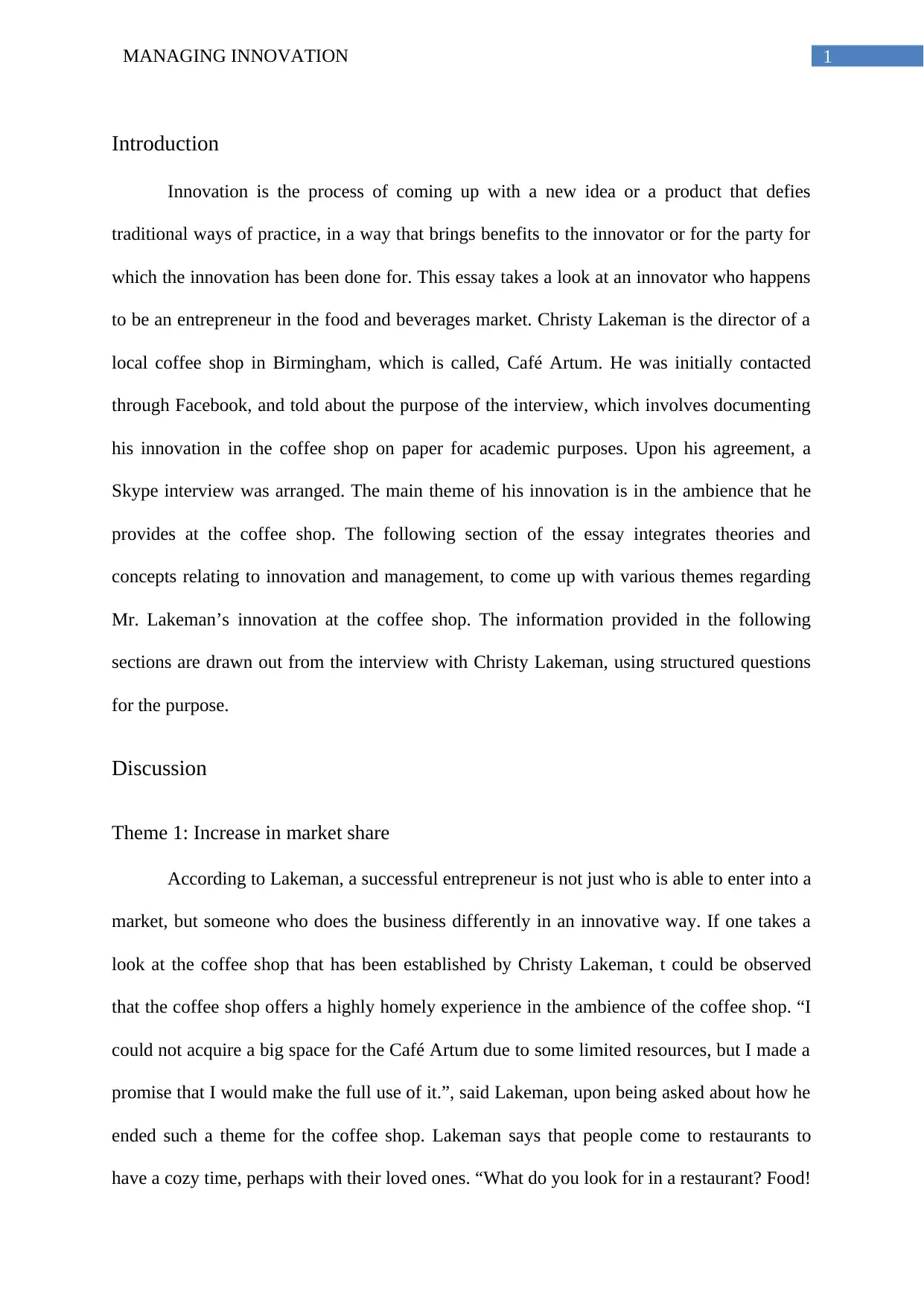
1MANAGING INNOVATION
Introduction
Innovation is the process of coming up with a new idea or a product that defies
traditional ways of practice, in a way that brings benefits to the innovator or for the party for
which the innovation has been done for. This essay takes a look at an innovator who happens
to be an entrepreneur in the food and beverages market. Christy Lakeman is the director of a
local coffee shop in Birmingham, which is called, Café Artum. He was initially contacted
through Facebook, and told about the purpose of the interview, which involves documenting
his innovation in the coffee shop on paper for academic purposes. Upon his agreement, a
Skype interview was arranged. The main theme of his innovation is in the ambience that he
provides at the coffee shop. The following section of the essay integrates theories and
concepts relating to innovation and management, to come up with various themes regarding
Mr. Lakeman’s innovation at the coffee shop. The information provided in the following
sections are drawn out from the interview with Christy Lakeman, using structured questions
for the purpose.
Discussion
Theme 1: Increase in market share
According to Lakeman, a successful entrepreneur is not just who is able to enter into a
market, but someone who does the business differently in an innovative way. If one takes a
look at the coffee shop that has been established by Christy Lakeman, t could be observed
that the coffee shop offers a highly homely experience in the ambience of the coffee shop. “I
could not acquire a big space for the Café Artum due to some limited resources, but I made a
promise that I would make the full use of it.”, said Lakeman, upon being asked about how he
ended such a theme for the coffee shop. Lakeman says that people come to restaurants to
have a cozy time, perhaps with their loved ones. “What do you look for in a restaurant? Food!
Introduction
Innovation is the process of coming up with a new idea or a product that defies
traditional ways of practice, in a way that brings benefits to the innovator or for the party for
which the innovation has been done for. This essay takes a look at an innovator who happens
to be an entrepreneur in the food and beverages market. Christy Lakeman is the director of a
local coffee shop in Birmingham, which is called, Café Artum. He was initially contacted
through Facebook, and told about the purpose of the interview, which involves documenting
his innovation in the coffee shop on paper for academic purposes. Upon his agreement, a
Skype interview was arranged. The main theme of his innovation is in the ambience that he
provides at the coffee shop. The following section of the essay integrates theories and
concepts relating to innovation and management, to come up with various themes regarding
Mr. Lakeman’s innovation at the coffee shop. The information provided in the following
sections are drawn out from the interview with Christy Lakeman, using structured questions
for the purpose.
Discussion
Theme 1: Increase in market share
According to Lakeman, a successful entrepreneur is not just who is able to enter into a
market, but someone who does the business differently in an innovative way. If one takes a
look at the coffee shop that has been established by Christy Lakeman, t could be observed
that the coffee shop offers a highly homely experience in the ambience of the coffee shop. “I
could not acquire a big space for the Café Artum due to some limited resources, but I made a
promise that I would make the full use of it.”, said Lakeman, upon being asked about how he
ended such a theme for the coffee shop. Lakeman says that people come to restaurants to
have a cozy time, perhaps with their loved ones. “What do you look for in a restaurant? Food!
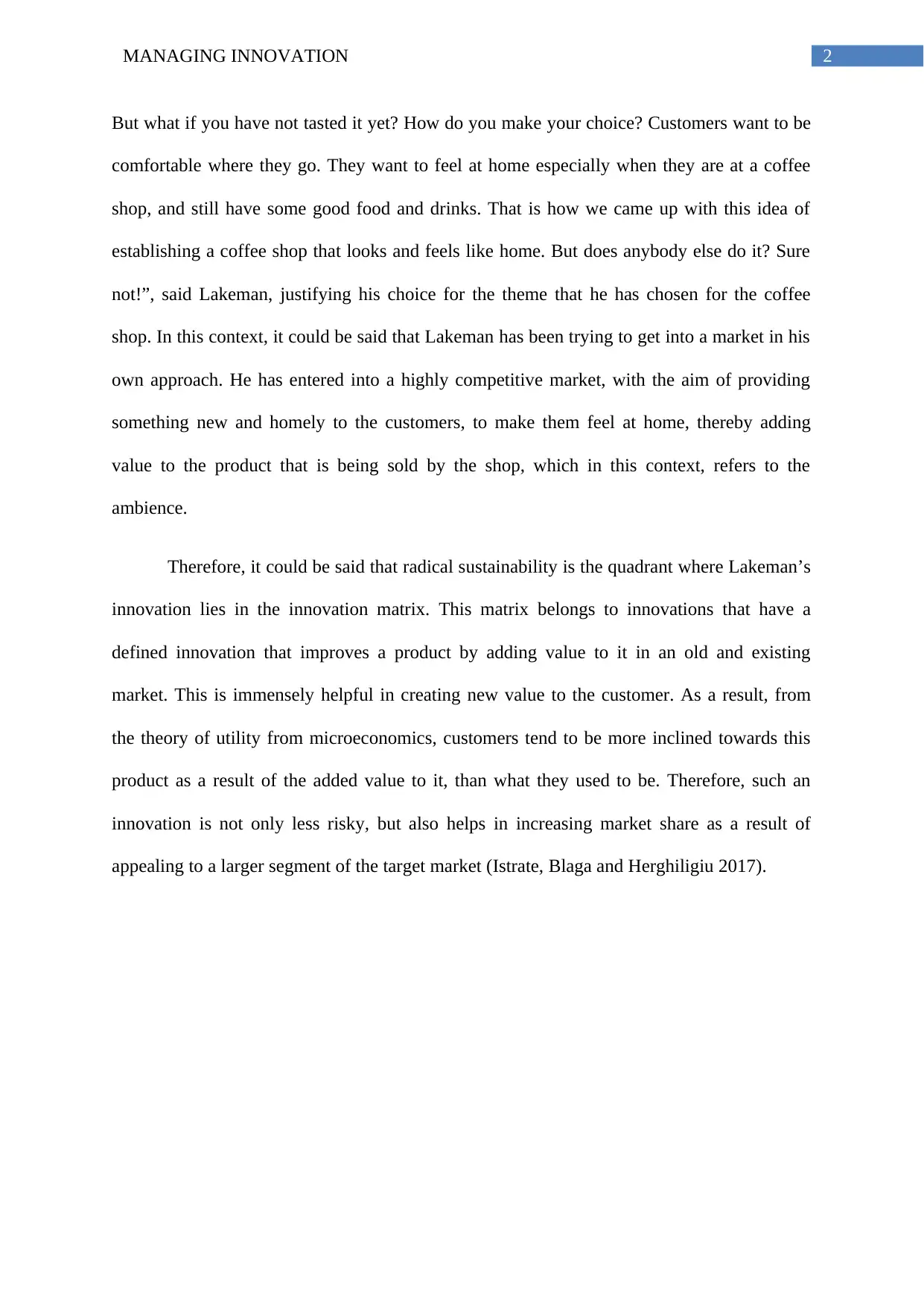
2MANAGING INNOVATION
But what if you have not tasted it yet? How do you make your choice? Customers want to be
comfortable where they go. They want to feel at home especially when they are at a coffee
shop, and still have some good food and drinks. That is how we came up with this idea of
establishing a coffee shop that looks and feels like home. But does anybody else do it? Sure
not!”, said Lakeman, justifying his choice for the theme that he has chosen for the coffee
shop. In this context, it could be said that Lakeman has been trying to get into a market in his
own approach. He has entered into a highly competitive market, with the aim of providing
something new and homely to the customers, to make them feel at home, thereby adding
value to the product that is being sold by the shop, which in this context, refers to the
ambience.
Therefore, it could be said that radical sustainability is the quadrant where Lakeman’s
innovation lies in the innovation matrix. This matrix belongs to innovations that have a
defined innovation that improves a product by adding value to it in an old and existing
market. This is immensely helpful in creating new value to the customer. As a result, from
the theory of utility from microeconomics, customers tend to be more inclined towards this
product as a result of the added value to it, than what they used to be. Therefore, such an
innovation is not only less risky, but also helps in increasing market share as a result of
appealing to a larger segment of the target market (Istrate, Blaga and Herghiligiu 2017).
But what if you have not tasted it yet? How do you make your choice? Customers want to be
comfortable where they go. They want to feel at home especially when they are at a coffee
shop, and still have some good food and drinks. That is how we came up with this idea of
establishing a coffee shop that looks and feels like home. But does anybody else do it? Sure
not!”, said Lakeman, justifying his choice for the theme that he has chosen for the coffee
shop. In this context, it could be said that Lakeman has been trying to get into a market in his
own approach. He has entered into a highly competitive market, with the aim of providing
something new and homely to the customers, to make them feel at home, thereby adding
value to the product that is being sold by the shop, which in this context, refers to the
ambience.
Therefore, it could be said that radical sustainability is the quadrant where Lakeman’s
innovation lies in the innovation matrix. This matrix belongs to innovations that have a
defined innovation that improves a product by adding value to it in an old and existing
market. This is immensely helpful in creating new value to the customer. As a result, from
the theory of utility from microeconomics, customers tend to be more inclined towards this
product as a result of the added value to it, than what they used to be. Therefore, such an
innovation is not only less risky, but also helps in increasing market share as a result of
appealing to a larger segment of the target market (Istrate, Blaga and Herghiligiu 2017).
⊘ This is a preview!⊘
Do you want full access?
Subscribe today to unlock all pages.

Trusted by 1+ million students worldwide
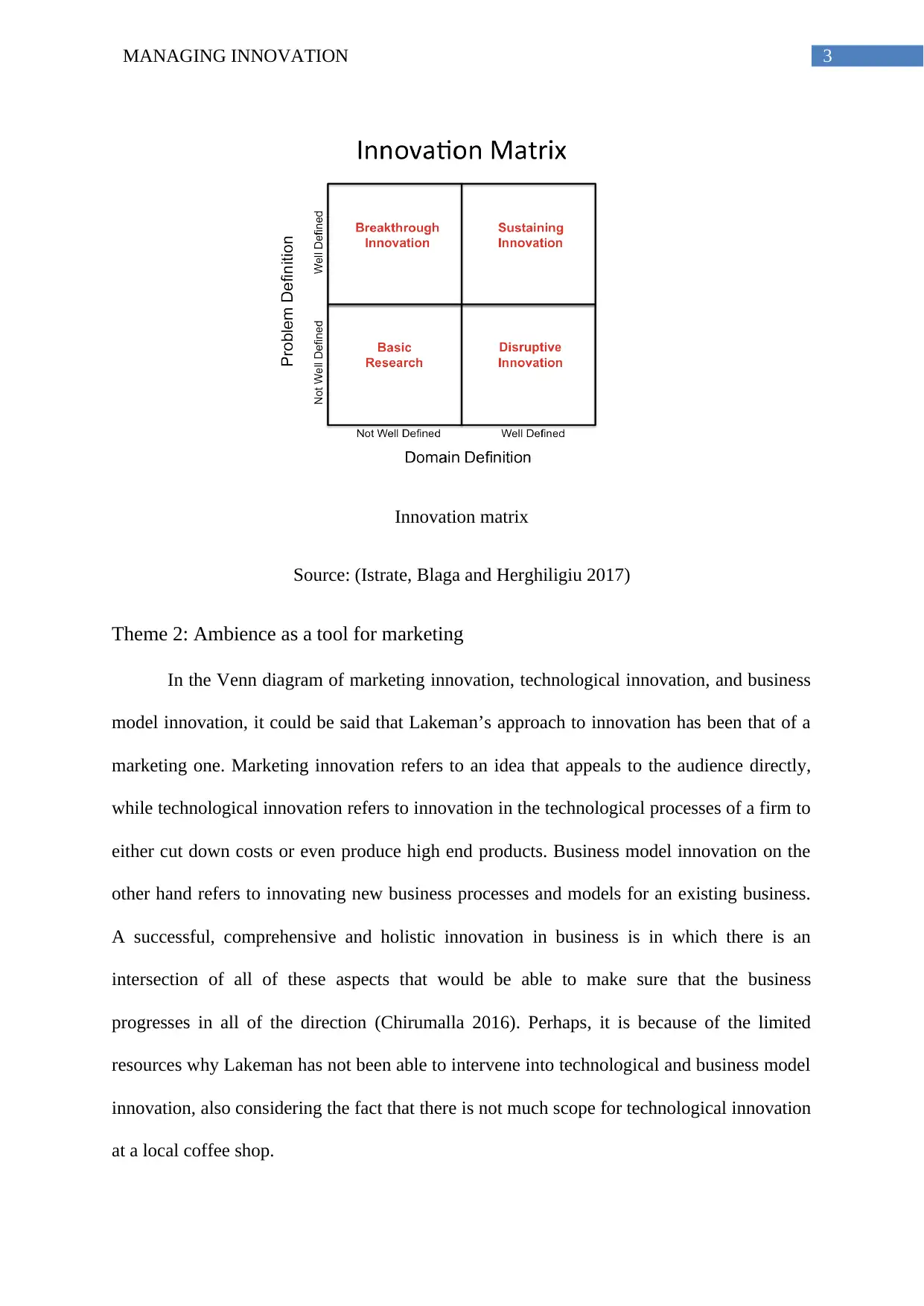
3MANAGING INNOVATION
Innovation matrix
Source: (Istrate, Blaga and Herghiligiu 2017)
Theme 2: Ambience as a tool for marketing
In the Venn diagram of marketing innovation, technological innovation, and business
model innovation, it could be said that Lakeman’s approach to innovation has been that of a
marketing one. Marketing innovation refers to an idea that appeals to the audience directly,
while technological innovation refers to innovation in the technological processes of a firm to
either cut down costs or even produce high end products. Business model innovation on the
other hand refers to innovating new business processes and models for an existing business.
A successful, comprehensive and holistic innovation in business is in which there is an
intersection of all of these aspects that would be able to make sure that the business
progresses in all of the direction (Chirumalla 2016). Perhaps, it is because of the limited
resources why Lakeman has not been able to intervene into technological and business model
innovation, also considering the fact that there is not much scope for technological innovation
at a local coffee shop.
Innovation matrix
Source: (Istrate, Blaga and Herghiligiu 2017)
Theme 2: Ambience as a tool for marketing
In the Venn diagram of marketing innovation, technological innovation, and business
model innovation, it could be said that Lakeman’s approach to innovation has been that of a
marketing one. Marketing innovation refers to an idea that appeals to the audience directly,
while technological innovation refers to innovation in the technological processes of a firm to
either cut down costs or even produce high end products. Business model innovation on the
other hand refers to innovating new business processes and models for an existing business.
A successful, comprehensive and holistic innovation in business is in which there is an
intersection of all of these aspects that would be able to make sure that the business
progresses in all of the direction (Chirumalla 2016). Perhaps, it is because of the limited
resources why Lakeman has not been able to intervene into technological and business model
innovation, also considering the fact that there is not much scope for technological innovation
at a local coffee shop.
Paraphrase This Document
Need a fresh take? Get an instant paraphrase of this document with our AI Paraphraser
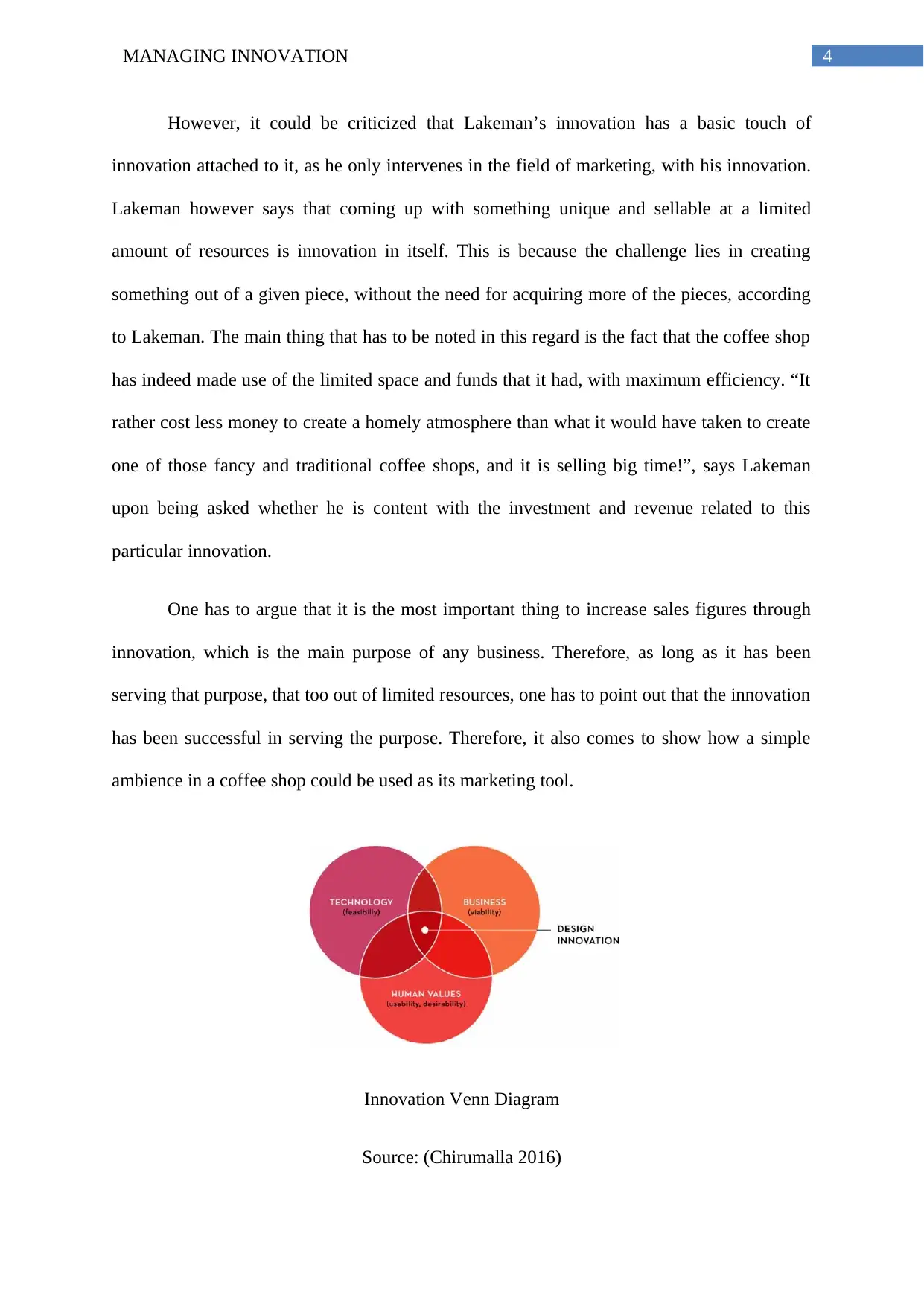
4MANAGING INNOVATION
However, it could be criticized that Lakeman’s innovation has a basic touch of
innovation attached to it, as he only intervenes in the field of marketing, with his innovation.
Lakeman however says that coming up with something unique and sellable at a limited
amount of resources is innovation in itself. This is because the challenge lies in creating
something out of a given piece, without the need for acquiring more of the pieces, according
to Lakeman. The main thing that has to be noted in this regard is the fact that the coffee shop
has indeed made use of the limited space and funds that it had, with maximum efficiency. “It
rather cost less money to create a homely atmosphere than what it would have taken to create
one of those fancy and traditional coffee shops, and it is selling big time!”, says Lakeman
upon being asked whether he is content with the investment and revenue related to this
particular innovation.
One has to argue that it is the most important thing to increase sales figures through
innovation, which is the main purpose of any business. Therefore, as long as it has been
serving that purpose, that too out of limited resources, one has to point out that the innovation
has been successful in serving the purpose. Therefore, it also comes to show how a simple
ambience in a coffee shop could be used as its marketing tool.
Innovation Venn Diagram
Source: (Chirumalla 2016)
However, it could be criticized that Lakeman’s innovation has a basic touch of
innovation attached to it, as he only intervenes in the field of marketing, with his innovation.
Lakeman however says that coming up with something unique and sellable at a limited
amount of resources is innovation in itself. This is because the challenge lies in creating
something out of a given piece, without the need for acquiring more of the pieces, according
to Lakeman. The main thing that has to be noted in this regard is the fact that the coffee shop
has indeed made use of the limited space and funds that it had, with maximum efficiency. “It
rather cost less money to create a homely atmosphere than what it would have taken to create
one of those fancy and traditional coffee shops, and it is selling big time!”, says Lakeman
upon being asked whether he is content with the investment and revenue related to this
particular innovation.
One has to argue that it is the most important thing to increase sales figures through
innovation, which is the main purpose of any business. Therefore, as long as it has been
serving that purpose, that too out of limited resources, one has to point out that the innovation
has been successful in serving the purpose. Therefore, it also comes to show how a simple
ambience in a coffee shop could be used as its marketing tool.
Innovation Venn Diagram
Source: (Chirumalla 2016)
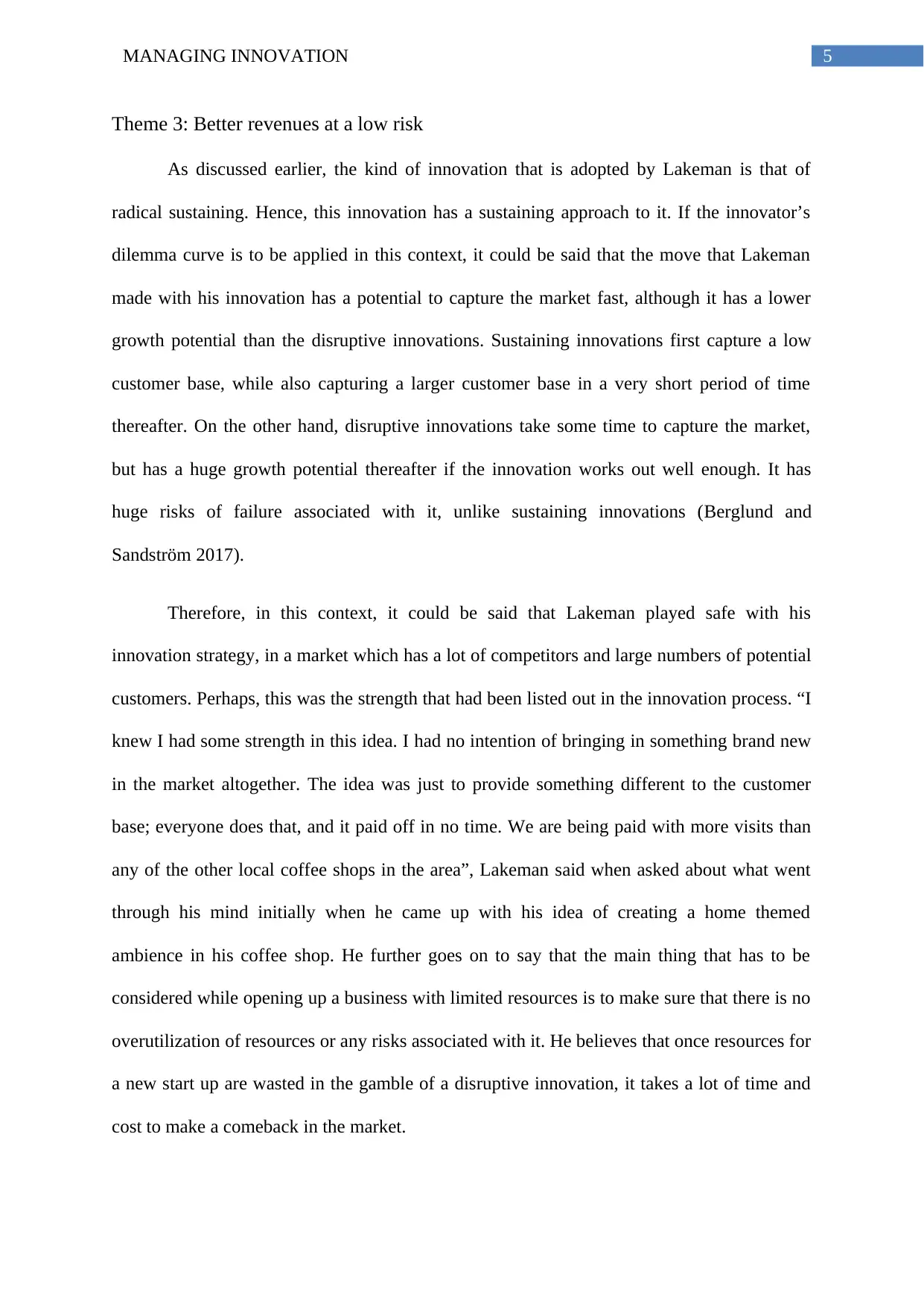
5MANAGING INNOVATION
Theme 3: Better revenues at a low risk
As discussed earlier, the kind of innovation that is adopted by Lakeman is that of
radical sustaining. Hence, this innovation has a sustaining approach to it. If the innovator’s
dilemma curve is to be applied in this context, it could be said that the move that Lakeman
made with his innovation has a potential to capture the market fast, although it has a lower
growth potential than the disruptive innovations. Sustaining innovations first capture a low
customer base, while also capturing a larger customer base in a very short period of time
thereafter. On the other hand, disruptive innovations take some time to capture the market,
but has a huge growth potential thereafter if the innovation works out well enough. It has
huge risks of failure associated with it, unlike sustaining innovations (Berglund and
Sandström 2017).
Therefore, in this context, it could be said that Lakeman played safe with his
innovation strategy, in a market which has a lot of competitors and large numbers of potential
customers. Perhaps, this was the strength that had been listed out in the innovation process. “I
knew I had some strength in this idea. I had no intention of bringing in something brand new
in the market altogether. The idea was just to provide something different to the customer
base; everyone does that, and it paid off in no time. We are being paid with more visits than
any of the other local coffee shops in the area”, Lakeman said when asked about what went
through his mind initially when he came up with his idea of creating a home themed
ambience in his coffee shop. He further goes on to say that the main thing that has to be
considered while opening up a business with limited resources is to make sure that there is no
overutilization of resources or any risks associated with it. He believes that once resources for
a new start up are wasted in the gamble of a disruptive innovation, it takes a lot of time and
cost to make a comeback in the market.
Theme 3: Better revenues at a low risk
As discussed earlier, the kind of innovation that is adopted by Lakeman is that of
radical sustaining. Hence, this innovation has a sustaining approach to it. If the innovator’s
dilemma curve is to be applied in this context, it could be said that the move that Lakeman
made with his innovation has a potential to capture the market fast, although it has a lower
growth potential than the disruptive innovations. Sustaining innovations first capture a low
customer base, while also capturing a larger customer base in a very short period of time
thereafter. On the other hand, disruptive innovations take some time to capture the market,
but has a huge growth potential thereafter if the innovation works out well enough. It has
huge risks of failure associated with it, unlike sustaining innovations (Berglund and
Sandström 2017).
Therefore, in this context, it could be said that Lakeman played safe with his
innovation strategy, in a market which has a lot of competitors and large numbers of potential
customers. Perhaps, this was the strength that had been listed out in the innovation process. “I
knew I had some strength in this idea. I had no intention of bringing in something brand new
in the market altogether. The idea was just to provide something different to the customer
base; everyone does that, and it paid off in no time. We are being paid with more visits than
any of the other local coffee shops in the area”, Lakeman said when asked about what went
through his mind initially when he came up with his idea of creating a home themed
ambience in his coffee shop. He further goes on to say that the main thing that has to be
considered while opening up a business with limited resources is to make sure that there is no
overutilization of resources or any risks associated with it. He believes that once resources for
a new start up are wasted in the gamble of a disruptive innovation, it takes a lot of time and
cost to make a comeback in the market.
⊘ This is a preview!⊘
Do you want full access?
Subscribe today to unlock all pages.

Trusted by 1+ million students worldwide
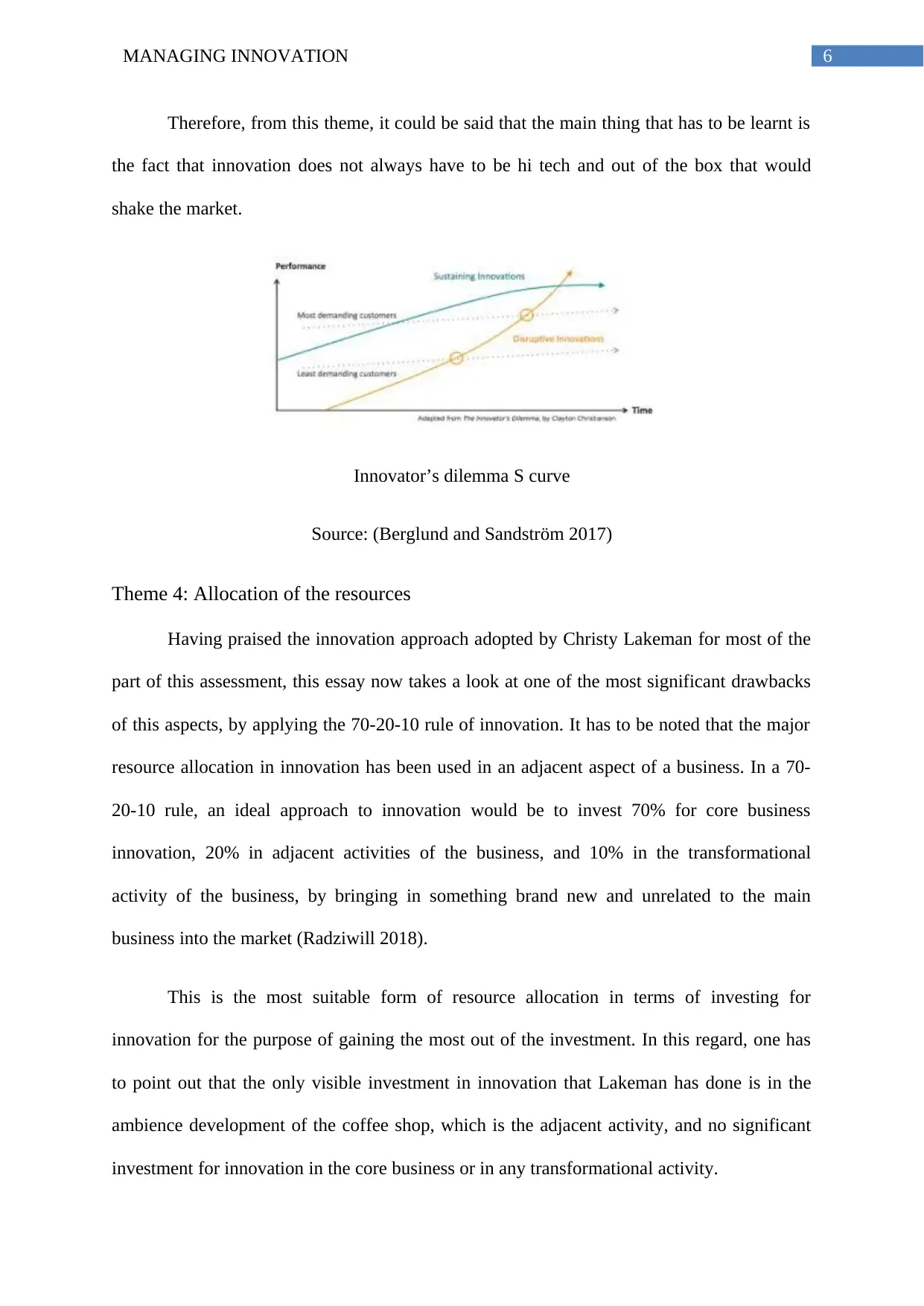
6MANAGING INNOVATION
Therefore, from this theme, it could be said that the main thing that has to be learnt is
the fact that innovation does not always have to be hi tech and out of the box that would
shake the market.
Innovator’s dilemma S curve
Source: (Berglund and Sandström 2017)
Theme 4: Allocation of the resources
Having praised the innovation approach adopted by Christy Lakeman for most of the
part of this assessment, this essay now takes a look at one of the most significant drawbacks
of this aspects, by applying the 70-20-10 rule of innovation. It has to be noted that the major
resource allocation in innovation has been used in an adjacent aspect of a business. In a 70-
20-10 rule, an ideal approach to innovation would be to invest 70% for core business
innovation, 20% in adjacent activities of the business, and 10% in the transformational
activity of the business, by bringing in something brand new and unrelated to the main
business into the market (Radziwill 2018).
This is the most suitable form of resource allocation in terms of investing for
innovation for the purpose of gaining the most out of the investment. In this regard, one has
to point out that the only visible investment in innovation that Lakeman has done is in the
ambience development of the coffee shop, which is the adjacent activity, and no significant
investment for innovation in the core business or in any transformational activity.
Therefore, from this theme, it could be said that the main thing that has to be learnt is
the fact that innovation does not always have to be hi tech and out of the box that would
shake the market.
Innovator’s dilemma S curve
Source: (Berglund and Sandström 2017)
Theme 4: Allocation of the resources
Having praised the innovation approach adopted by Christy Lakeman for most of the
part of this assessment, this essay now takes a look at one of the most significant drawbacks
of this aspects, by applying the 70-20-10 rule of innovation. It has to be noted that the major
resource allocation in innovation has been used in an adjacent aspect of a business. In a 70-
20-10 rule, an ideal approach to innovation would be to invest 70% for core business
innovation, 20% in adjacent activities of the business, and 10% in the transformational
activity of the business, by bringing in something brand new and unrelated to the main
business into the market (Radziwill 2018).
This is the most suitable form of resource allocation in terms of investing for
innovation for the purpose of gaining the most out of the investment. In this regard, one has
to point out that the only visible investment in innovation that Lakeman has done is in the
ambience development of the coffee shop, which is the adjacent activity, and no significant
investment for innovation in the core business or in any transformational activity.
Paraphrase This Document
Need a fresh take? Get an instant paraphrase of this document with our AI Paraphraser
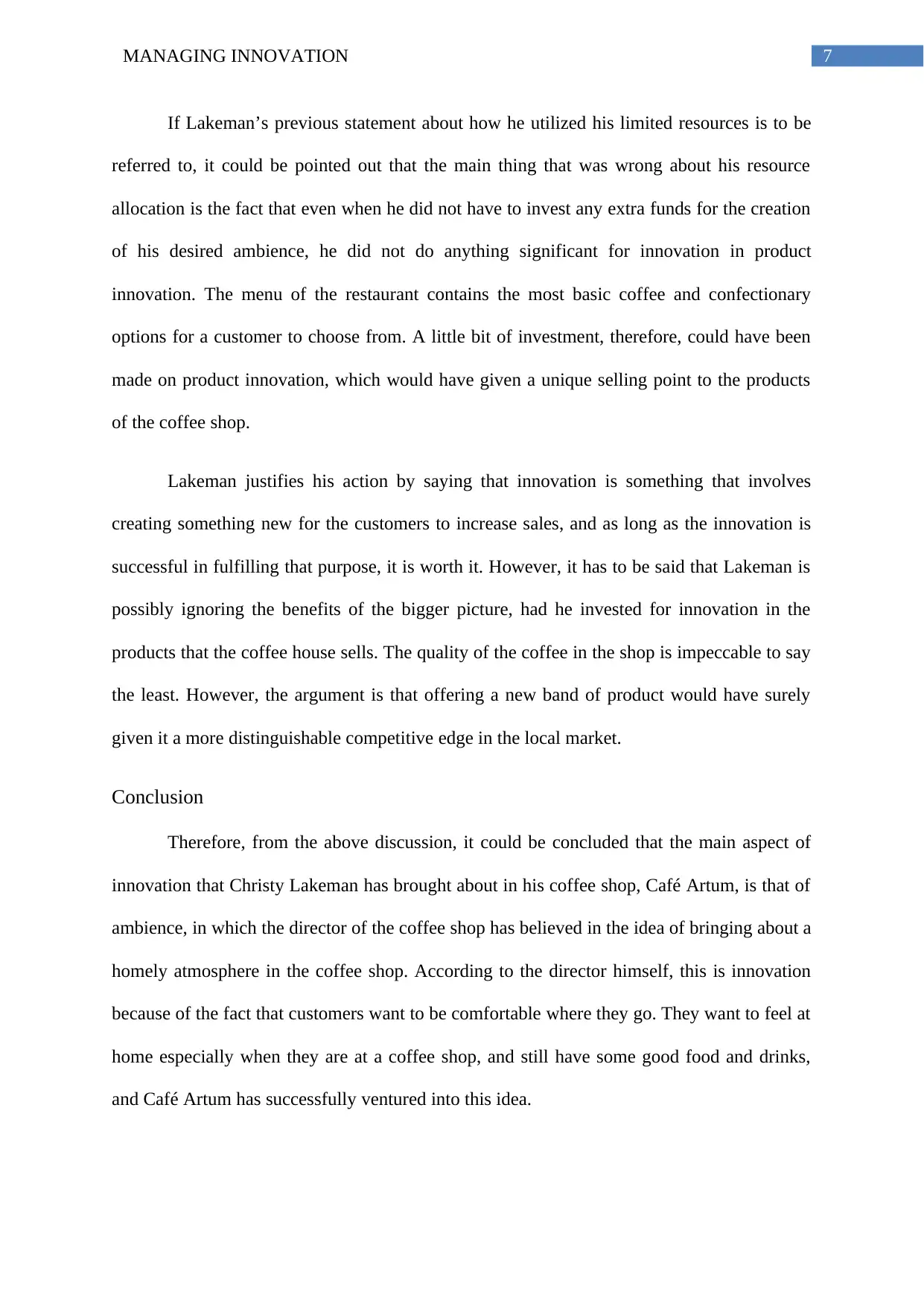
7MANAGING INNOVATION
If Lakeman’s previous statement about how he utilized his limited resources is to be
referred to, it could be pointed out that the main thing that was wrong about his resource
allocation is the fact that even when he did not have to invest any extra funds for the creation
of his desired ambience, he did not do anything significant for innovation in product
innovation. The menu of the restaurant contains the most basic coffee and confectionary
options for a customer to choose from. A little bit of investment, therefore, could have been
made on product innovation, which would have given a unique selling point to the products
of the coffee shop.
Lakeman justifies his action by saying that innovation is something that involves
creating something new for the customers to increase sales, and as long as the innovation is
successful in fulfilling that purpose, it is worth it. However, it has to be said that Lakeman is
possibly ignoring the benefits of the bigger picture, had he invested for innovation in the
products that the coffee house sells. The quality of the coffee in the shop is impeccable to say
the least. However, the argument is that offering a new band of product would have surely
given it a more distinguishable competitive edge in the local market.
Conclusion
Therefore, from the above discussion, it could be concluded that the main aspect of
innovation that Christy Lakeman has brought about in his coffee shop, Café Artum, is that of
ambience, in which the director of the coffee shop has believed in the idea of bringing about a
homely atmosphere in the coffee shop. According to the director himself, this is innovation
because of the fact that customers want to be comfortable where they go. They want to feel at
home especially when they are at a coffee shop, and still have some good food and drinks,
and Café Artum has successfully ventured into this idea.
If Lakeman’s previous statement about how he utilized his limited resources is to be
referred to, it could be pointed out that the main thing that was wrong about his resource
allocation is the fact that even when he did not have to invest any extra funds for the creation
of his desired ambience, he did not do anything significant for innovation in product
innovation. The menu of the restaurant contains the most basic coffee and confectionary
options for a customer to choose from. A little bit of investment, therefore, could have been
made on product innovation, which would have given a unique selling point to the products
of the coffee shop.
Lakeman justifies his action by saying that innovation is something that involves
creating something new for the customers to increase sales, and as long as the innovation is
successful in fulfilling that purpose, it is worth it. However, it has to be said that Lakeman is
possibly ignoring the benefits of the bigger picture, had he invested for innovation in the
products that the coffee house sells. The quality of the coffee in the shop is impeccable to say
the least. However, the argument is that offering a new band of product would have surely
given it a more distinguishable competitive edge in the local market.
Conclusion
Therefore, from the above discussion, it could be concluded that the main aspect of
innovation that Christy Lakeman has brought about in his coffee shop, Café Artum, is that of
ambience, in which the director of the coffee shop has believed in the idea of bringing about a
homely atmosphere in the coffee shop. According to the director himself, this is innovation
because of the fact that customers want to be comfortable where they go. They want to feel at
home especially when they are at a coffee shop, and still have some good food and drinks,
and Café Artum has successfully ventured into this idea.
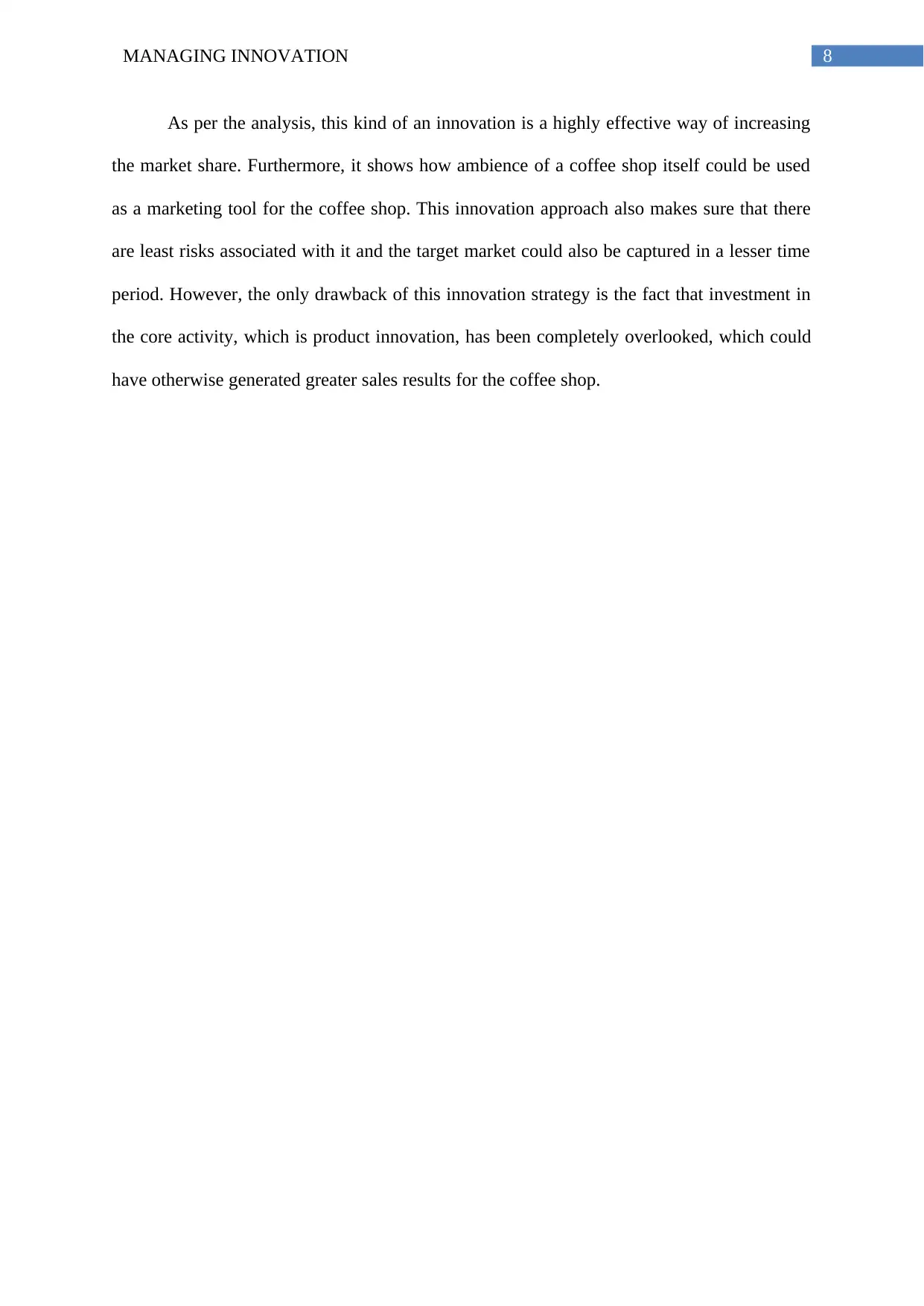
8MANAGING INNOVATION
As per the analysis, this kind of an innovation is a highly effective way of increasing
the market share. Furthermore, it shows how ambience of a coffee shop itself could be used
as a marketing tool for the coffee shop. This innovation approach also makes sure that there
are least risks associated with it and the target market could also be captured in a lesser time
period. However, the only drawback of this innovation strategy is the fact that investment in
the core activity, which is product innovation, has been completely overlooked, which could
have otherwise generated greater sales results for the coffee shop.
As per the analysis, this kind of an innovation is a highly effective way of increasing
the market share. Furthermore, it shows how ambience of a coffee shop itself could be used
as a marketing tool for the coffee shop. This innovation approach also makes sure that there
are least risks associated with it and the target market could also be captured in a lesser time
period. However, the only drawback of this innovation strategy is the fact that investment in
the core activity, which is product innovation, has been completely overlooked, which could
have otherwise generated greater sales results for the coffee shop.
⊘ This is a preview!⊘
Do you want full access?
Subscribe today to unlock all pages.

Trusted by 1+ million students worldwide
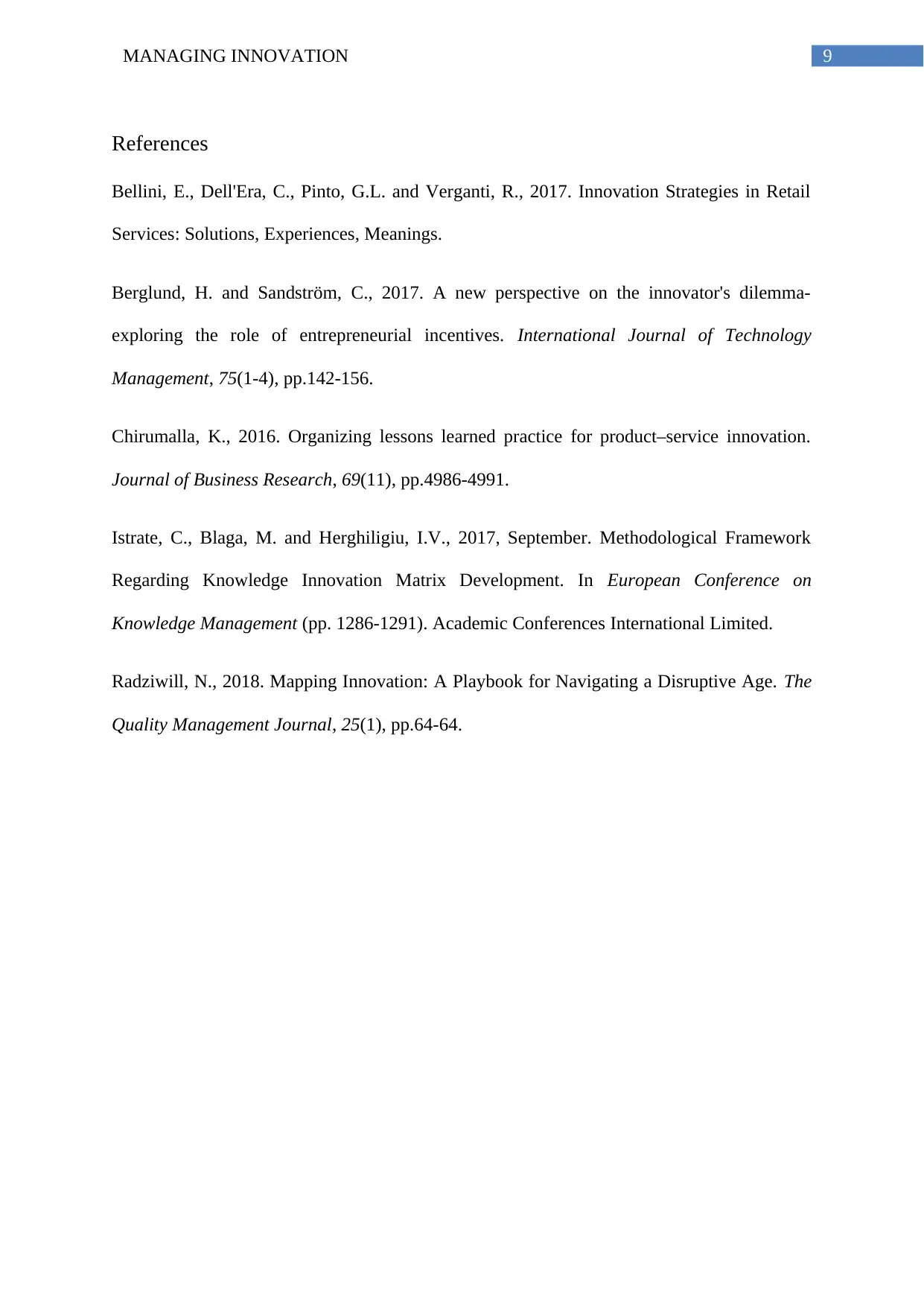
9MANAGING INNOVATION
References
Bellini, E., Dell'Era, C., Pinto, G.L. and Verganti, R., 2017. Innovation Strategies in Retail
Services: Solutions, Experiences, Meanings.
Berglund, H. and Sandström, C., 2017. A new perspective on the innovator's dilemma-
exploring the role of entrepreneurial incentives. International Journal of Technology
Management, 75(1-4), pp.142-156.
Chirumalla, K., 2016. Organizing lessons learned practice for product–service innovation.
Journal of Business Research, 69(11), pp.4986-4991.
Istrate, C., Blaga, M. and Herghiligiu, I.V., 2017, September. Methodological Framework
Regarding Knowledge Innovation Matrix Development. In European Conference on
Knowledge Management (pp. 1286-1291). Academic Conferences International Limited.
Radziwill, N., 2018. Mapping Innovation: A Playbook for Navigating a Disruptive Age. The
Quality Management Journal, 25(1), pp.64-64.
References
Bellini, E., Dell'Era, C., Pinto, G.L. and Verganti, R., 2017. Innovation Strategies in Retail
Services: Solutions, Experiences, Meanings.
Berglund, H. and Sandström, C., 2017. A new perspective on the innovator's dilemma-
exploring the role of entrepreneurial incentives. International Journal of Technology
Management, 75(1-4), pp.142-156.
Chirumalla, K., 2016. Organizing lessons learned practice for product–service innovation.
Journal of Business Research, 69(11), pp.4986-4991.
Istrate, C., Blaga, M. and Herghiligiu, I.V., 2017, September. Methodological Framework
Regarding Knowledge Innovation Matrix Development. In European Conference on
Knowledge Management (pp. 1286-1291). Academic Conferences International Limited.
Radziwill, N., 2018. Mapping Innovation: A Playbook for Navigating a Disruptive Age. The
Quality Management Journal, 25(1), pp.64-64.
1 out of 10
Your All-in-One AI-Powered Toolkit for Academic Success.
+13062052269
info@desklib.com
Available 24*7 on WhatsApp / Email
![[object Object]](/_next/static/media/star-bottom.7253800d.svg)
Unlock your academic potential
Copyright © 2020–2025 A2Z Services. All Rights Reserved. Developed and managed by ZUCOL.


